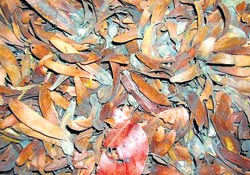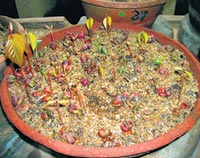
Spreading the splendour of SalQueen Maya, the mother of Lord Buddha, while giving birth to Him is said to have held onto a branch of a blossoming 'Sal tree'. Since then the 'Sal tree' has been revered by Buddhists. In Sri Lanka, people have planted trees in most Buddhist temples under the mistaken belief that they were planting 'Sal' trees. The tree generally known as the 'Sal tree' in Sri Lanka is in fact, the Cannonball tree (Couroupita Guianensis) which has its origin in South America. It was introduced to the Botanical Gardens in 1881 and since then has spread around Sri Lanka.
The Director General of the National Botanical Gardens Dr. D.S.A. Wijesundera believes this confusion has to be rectified. Minister of Irrigation and Water Management Chamal Rajapakse being anxious to correct the misnomer that the Guinean Cannonball tree was the 'Sal' of Nepal, had contacted Nepal and Sri Lanka's Ambassador in Nepal Sumith Nakandala had obtained a kilo of Sal seeds which has now been sent to the Peradeniya Botanical Gardens. Some of these 'Sal' seeds had, in fact, germinated on the way to Sri Lanka. If these seeds are not germinated within seven days, their lifespan would be over, Mr. Wijesundera explains. The National Botanical Gardens at Peradeniya was entrusted with the germination of these seeds and since May these seedlings are being grown there. Dr. Wijesundera with the Deputy Director of the Gardens Rasika Nanayakkara have been taking care to ensure the successful germination of the seeds. The 'Sal Tree' is said to be a handsome tree providing good quality timber, unlike the Cannonball tree. Its botanical family is 'dipterocarpaceae'. It is also known as 'salwa, sakhu, shal, kinder and sakwa’ in Asian countries. This tree grows upto a height of around 35 metres and reaches a girth of about 2 to 2.5 metres in around 100 years.
This tree is found in Burma, Assam, Bengal and Nepal. Sal trees grown in Nepal and the Singhbhum districts of Bihar are considered to be the best variety. The tree is erect and cylindrical, similar to the Cannonball tree which perhaps accounts for the mistake made by Sri Lankans for quite a long time. The Sal tree is worshipped by Buddhists and Hindus in neighbouring countries. In Sri Lanka, the Cannonball tree flower is used as a temple flower for offerings. It is said that the famous Lumbini area where Lord Buddha had sat for meditation and where He was born was in a thick forest of Sal trees.According to Dr. Wijesundera, the ' Sal' tree is seldom completely leafless, but in dry regions, the tree tends to shed practically all its leaves for a short period from February to April and the leaves appear during April and May. The ' Sal ' flowers are whitish in colour and appear in early April- May. It comes out in auxiliary racemos panicles covered with white pubescence. It is reported that the seeds ripen from June to July and they tend to germinate even while on the tree. 'Sal' wood is most suitable for such applications where strength and elasticity are foremost requirements and where polishing is not so very essential. In India the Sal tree is considered as a 'famine ' food as the seeds are boiled into a porridge. With the next tree planting ceremonies the original 'Sal' plants will be distributed among temples in the country. King Birendra when he visited Sri Lanka, with his Queen planted a 'Sal Tree ' brought from Nepal, which is the only 'Sal' tree presently growing in the Peradeniya Gardens. |
|| Front
Page | News | Editorial | Columns | Sports | Plus | Financial
Times | International | Mirror | TV
Times | Funday
Times | Kandy
Times || |
| |
Copyright
2007 Wijeya
Newspapers Ltd.Colombo. Sri Lanka. |

